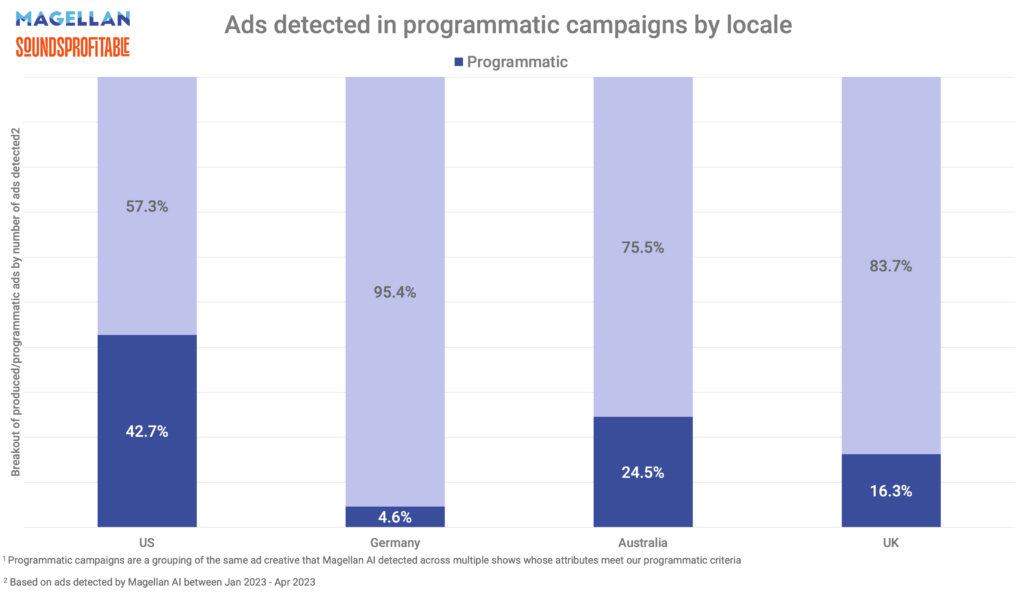This Week in the Business of Podcasting
Cool autumnal winds have reached my corner of the world, signaling we’re well past the halfway point of the year and able to look back on where we’ve come. Some of this week’s news follows suit, using podcasting’s history to give perspective on how we can move forward. Let’s get into it.

Track behaviors, trends, and insights: Download Magellan AI’s podcast advertising benchmark report for Q2
Pierre Bouvard: AM/FM Radio and Podcasts Could Recapture Lost TV Reach
A new study from MARU and Matchbox National Study surveyed 1,003 respondents this August on their TV habits during the ongoing WGA and SAG-AFTRA strike. 27% of respondents say they’ll watch less linear TV this fall season due to increased re-runs of old content, game shows, and reality TV.
Among those who said they’ll watch less TV due to strike-altered content, 68% said they intend to replace TV watching time with listening to podcasts, music, and AM/FM radio. Using Nielsen Commspoint data from 2021, Bouvard demonstrates that moving 20% of a $4 million TV campaign’s budget to AM/FM radio increases reach with people aged 25-54 by 70%.
As Sounds Profitable’s The Medium Moves the Message study demonstrated back in March, podcasting was getting close to TV’s weekly reach with viewers 18-34 before the strike started. As fall TV slowdown kicks in, audio’s already-valuable contributions to multimedia ad buys potentially will grow even more.
Digital Ad Spend Showing Promising Recovery After Recession Fears
After many months of recession woes and economic uncertainty throwing advertising for a loop, signs point toward the industry healing. First, from a Digiday article posted this Tuesday, Booster’s 2023 Media Ad Sales Trend Report and Operative’s H1 2023 Benchmarking Report. Both show publisher digital advertising revenue is recovering from the advertising decline that started last year. Hearst Magazines also reports an upswing in an interview on the Digiday Podcast. EVP Lisa Howard told Digiday she’s seeing more requests for proposals from advertisers for 2024 than this time last year.
According to AdExchanger coverage of a recent Magna forecast, U.S. media advertising sales increased 4.4% in Q2, beating June expectations by .8%. Magna has revised their 2024 ad spend forecast from 5% growth to 5.6%, with a potential for up to 8% thanks to the U.S. elections and 2024 Olympic games.
AdWeek does note that while marketers in travel, pharmaceuticals, retail, and consumer packaged-goods delivered strong spending in Q2, spend was flat or slightly up for automotive and entertainment. Financial and tech sectors are still down year-over-year in the Magna data. As Adweek suggests, the digital ad sales pulling out of a trench might not be pulling traditional media back up with it.
FTC Warns Against “Blurred Advertising” When Marketing to Kids
This Monday from Ryan Barwick at MarketingBrew: The Federal Trade Commission has published new recommendations for advertisers intending to further distinguish the difference between entertainment and advertisement. The more organic and content-like an advertisement is, the more the FTC is concerned children won’t be able to understand they’re watching a paid advertisement. A quote from Samuel Levine, director of the FTC’s Bureau of Consumer Protection:
“We now live in a world where kids spend many hours a day online, often in immersive environments where advertising and content are deliberately difficult to distinguish.”
The FTC post urges that kid’s entertainment and educational content should be clearly defined from ads, with visual and verbal cues to signal children are about to watch an ad. On the publishing side, the FTC recommends bringing back some version of the old-school “we’ll be right back after these commercial messages” disclaimer before an ad break. For ads, they recommend stakeholders develop a widely-used on-screen icon that tells kids money or free product was provided to content creators to advertise a product.
These new recommendations tie into the FTC’s endorsement guidelines that were updated earlier this summer, furthering the goal of clearly separating advertisement from content and defining endorsement.
CDC Reframes Flu Narrative Using Digital Display and Audio Campaign
This Wednesday from AdExchanger’s Hana Yoo: Flu vaccination rates have plummeted for both pregnant people and children (16% and 7% respectively), leading to elevated rates of severe flu cases, hospitalization, and death. In part this is attributed to the misconception flu vaccines are ineffective due to frequent online testimony that vaccinated people caught the flu anyway.
To combat the misinformation, the Center for Disease Control has launched a targeted ad campaign communicating that vaccines greatly decrease the intensity of the flu if you do catch it. The campaign is set to run September through January, specifically targeting pregnant people and parents of younger children with paid placement in digital environments where they’re spending time and seeking health information. In addition to traditional Facebook and Instagram placements, the CDC is also working with pregnancy app Peanut, microinfluencers, and a series of digital radio spots on Pandora.
If podcasting can get its foot in the door, our industry is primed to play a vital role in similar public health campaigns in future. Repeatedly, podcasting has proven its ability to target niche audiences well using contextual targeting of first-party data, and podcast audiences have a track record of high attention and engagement with creatives made specifically for podcasts. Radio spots on Pandora is a good first step, but it’s up to podcasting if we want to pitch in on the next Wild to Mild-sized public health campaign.
Industry Insights with Magellan AI
Using Magellan AI’s algorithm to group produced ads based on similar creatives, we broke out the share of programmatic ads detected by locale in Q1 2023. The US market had the largest share, with Magellan AI detecting 42% programmatic ads. Conversely the smallest share was in the German market with just 5% programmatic ads detected.
Looking to get a handle on podcast advertising metrics? Book a demo with the Magellan AI team.
Quick Hits
While they may not be top story material, the articles below from this week are definitely worth your time:
- I’m Not Exactly Sure What You Do by Tom Webster. There are many people out there who would love podcasts, if only we could easily tell them what podcasts are.
- You Don’t Deserve An Audience by Steve Pratt. Pratt interviews Tom Webster on the hard work one needs to put into a podcast to properly grow one.
- NASA to release first full season of Spanish-language podcast by Reem Makari. In time with celebration of Hispanic Heritage Month, NASA is launching it first full podcast in Spanish.
- Top spenders, movers and shakers in August by Magellan AI. The top spenders include HelloFresh, Amazon, and Betterhelp.
- Triton Digital Unveils Canada Podcasts Trends Report. The snapshot of Canada’s podcast landscape includes the finding that listeners downloaded 4.4 episodes per week on average, and the top day of the week for podcasting is Wednesday, with peak times between 10am and 12pm EST.







































































































































































































